|
|
|
|||
|
|
||||
|
|
||||
| The (Jet)X Files | ||||
|
|
HOME | SITE MAP | FORUM | CONTACT |
|
||
|
ABOUT | MOTORS | MODELS | ARCHIVE | HISTORY | STORE | FAQ | LINKS
|
|
|
|
|
|
|||||||||||||||||||||||||||||||||||||||||||||||||||||||||||||||||||||||
|
The (Jet)X Files 12
(December 2003)
by Roger Simmonds Reprinted from SAM 35 Speaks, December 2003 Tailored Models and Augmenter Tubes
|
|
|||||||||||||||||||||||||||||||||||||||||||||||||||||||||||||||||||||||
|
The ‘Zyra’ spaceship [right] was an earlier essay in Tailored technology, launched, if that is the right word, to coincide with the 1951 film, "When Worlds Collide". The Zyra featured moulded balsa fuselage halves and crude all sheet flying surfaces, whilst the Jetex 50 was mounted in the rear. Bert says of this product, "though it was an established line, and a popular kit, as a flying model it was it was a disaster … an impossibility … If you look into the design, there’s no way that it can fly". The plan is readily available, so perhaps I could persuade Tony Betts to try one! Bert insists that models he was responsible for as chief designer were comprehensively tested. The first prototype of the Jetmaster Hunter, for example, had a traditional built up fuselage (see photo [right]), and flew well, as did subsequent demonstration models of the kit. The "secret", says Bert, was to keep the weight below 4½ oz, and operational Hunters, as opposed to the display model presented to Sir Sydney Camm [below right], had a light silver finish. Alan Wiggs, in common with other correspondents, says his Hunter would not fly more than 75 yards even in a flat calm. The Hunter advertisements quote a weight of 4 oz; difficult to achieve with inexpert building and all that pale green dope. The Jetmaster could also have been a factor in the disappointing performances, as it needed careful maintenance to achieve its rated thrust. Significantly, Bert tells the story of the Tailored Swift (his favourite model) flying into the distance in a most spectacular way when powered by the more powerful Jetex 200.
Bert’s plan for the Lynx (discussed last month) revealed that, contrary to what I thought, the |
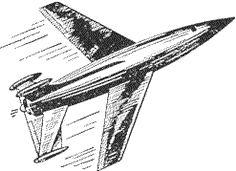
- Aeromodeller, Dec. 1951
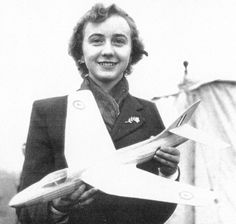
- photo courtesy of Mike Ingram
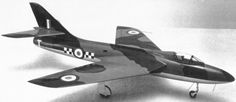
- photo courtesy of Mike Ingram
|
|||||||||||||||||||||||||||||||||||||||||||||||||||||||||||||||||||||||
|
|
|
|||
|
Pete designed the delightful little delta Interceptor, and reminisced about this ARTF model: "The motor (a 50B) was on a nose pod that slid into the front [see photo, below right], and you think the nose is going to shoot away from the rest of the body when the motor is lit. When determining the motor’s optimum position in the mouth of the augmenter tube, I was amazed to find that the augmenter tube was sucked forward onto the motor. You would expect the jet stream to blow the augmenter tube away, but that didn’t happen because the jet stream pulled the nose and tail together. The augmenter tube was like a reduction gear, drawing in extra air along with the jet stream. You get a larger volume of gas travelling at a much lower speed producing a greater thrust. The motor and augmenter tube together are really one unit, and the thrust point is at the tailpipe end". The Interceptor, with its paper covered balsa wings, is reminiscent of earlier FROG models (see photo), and I hope to have an example flying next year. As an aside, Pete said the only person to crash his demonstrator was the De Havilland test pilot, John Cunningham! Bert also had a plan of the ‘Mach 1’ Tailored Crusader [right]. This was a splendid little model that had some similarities to the earlier Starfighter, for example hinged control surfaces and a thrust deflector plate to facilitate trimming, but there is a lot more area in its stability-enhancing swept wing. Ron Pasco wrote to me about the Starfighter, "It was like a rocket … it really did motor but in a straight line so you had to be careful where you were pointing it. Of course it came to earth very quickly when the power cut out". He says the Crusader "flew quite well, though accuracy in building was very important, otherwise it would crash at the first attempt." Alternatives to Jetex |
  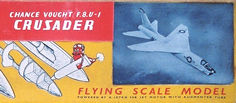
- Roger Simmonds
|
|||
|
Whilst the building of early examples of rocket planes is to be encouraged, some of the weird and not so wonderful rocket ‘motors’ of the early post war period appear most dangerous and best avoided. A small, safe and practicable turbojet or liquid fuelled rocket was beyond the technology of the time. Nonetheless, visionaries and engineers could pipe dream. John Scott-Scott, later involved in the Black Knight satellite launcher, experimented with hydrogen peroxide motors when he was a sixth former in Doncaster just after the War (see Backroom Boys, by Francis Spufford, highly recommended), but few boys had his resources or engineering acumen. SAM 35 Speaks (July 1999) refers to another wartime Model Engineer article by Laurence Sparey. This article, "Jet Propulsion Methods" is by all accounts quite sensible and he makes no attempt to maim his readers. The Karovodine turbine illustrated is quite sophisticated, though beyond the engineering dexterity of most modellers, even if (after pursuing Sparey’s previous suggestions) they retained a full digital complement. Some reaction motor designs did make it to a prototype, and I can’t resist this athodyd from the late forties, published in The New Book of Flight, (1948). If any reader knows anything about this one please let me know. It was attempts like these that would eventually lead to today’s successful small turbojets, which, miracles of micro engineering precision though they are, hold little interest for us. |
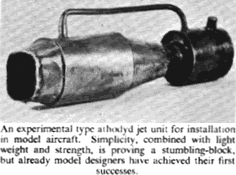
- The New Book of Flight, 1948
|
|||
|
Many of the cruder ‘jet type’ motors thought suitable for our sorts of model were reviewed in a comprehensive series of articles, "Jet Propulsion and the Model", that appeared in Model Aircraft (MA) between January and June 1956. These covered everything from pulse-jets and afterburners to Jetex units and ducted fans. Some of the devices were plainly ridiculous; for example one involved heated petrol sprayed from CO2 cartridge into an ‘afterburner’ tube. Apparently this was even manufactured as the ‘Minnesota Engine Works 601". Ian McQueen in the US had one of these in the early fifties. "It was", he wrote, "a good blowtorch, but had no measurable thrust". Edward Jones of the Rocket Science Institute says he never figured out how they imagined it would function. |

- Model Aircraft, Mar. 1956 (p. 109)
|
|||
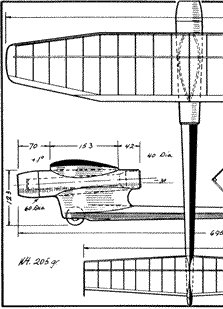
|
|
 by H. Lutjen
- Frank Zaic's Model Aeronautic Yearbook, 1953 (p. 105)
|
|
|
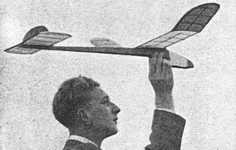
- Aeromodeller, Feb. 1951 (p. 85)

- Model Airplane News, Feb. 1953 (p. 17)
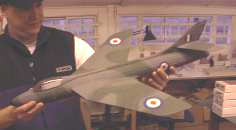 |
|
||||
|
The February MA article is a sensible one about Jetex and the fifth featured ducted fan (DF) propulsion. Now this mode of propulsion should please true vintage enthusiasts, as Phil Smith has pointed out that his semi scale Lavochkin La 17 [right] was flying well before 1950, though it was first kitted in 1952. Mike Mellor says this was another ’nose pressed to the window’ model, and there is a good review of it in MA, Oct. 1952. This conceded that, "trimming for flight could be a little tricky", but, "anyone who has seen the Lavochkin in action cannot fail to be impressed … the model looks, and sounds, like a true 'jet' in flight". Interested readers should seek out the seminal articles by Phil Smith (MA, June 1952) and M M Gates (MA, April 1953). The latter includes examples of centrifugal fans, which are all but unknown today. The low revving diesel engines of the fifties were not altogether optimal for ducted fan applications, and I am amazed at the success achieved by Phil Smith, P E Norman and others with these motors. However, modern electric motors are eminently suited to the high power at extreme rpm that efficient ducted fans require. It will not have escaped the more perspicacious readers that there has been a revival of small free flight ducted fan models, made possible by the availability of powerful electric motors and light, energy-packed batteries. If one wants a relatively painless introduction to electric ducted fan (EDF), have a look the 20" span Hawker Hunter and associated KP power pack from Aerographics [right] (see Model Flyer, Feb. 2002). This model is comparable to the Jetex Hunter, and weighs 5-6 oz with batteries. It certainly flies well; in fact so nice is this particular model one could be tempted to buy one and "back convert" it to Jetmaster/augmenter tube power! Established designs like the Phil Smith’s Lavochkin La 17 and later Fairey Delta 2, and P E Norman’s early free flight designs should fly well with a commercial EDF unit of 100 watts or so. |
||||||
|
There are now sub-miniature units and batteries suitable for even smaller models (see the Grand Wing Servo Tech website)). One of these, the EDF-30 [right], is about 1.5" diameter and has a quoted thrust of 21g (0.74 oz) for a 10 watt input. Now this would fit quite nicely into a Jetex 50 size model, for example a KeilKraft MiG 15, and I see no reason why it wouldn’t fly very well, if not at its usual very high speed. There has been some discussion on the ModelJetPlane discussion group about ‘micro EDF’ and there is a Huckebein and an F-107 awaiting trials in the US. Twins can be attempted with confidence, and Phillip Conroy in the UK, I know, wants to build an EDF SARO A/1. Getting a 13" EDF Panther to fly is quite a challenge, but flying sessions will be cheaper (after the initial expense), and flight patterns of models more predictable; this might suit some temperaments. There is also another good reason for taking EDF conversions seriously, brought into focus by this year’s very hot and dry summer. Many flying sites are adjacent to standing crops or long grass; it is just not responsible to fly Jetex or Rapiers in these conditions. EDF offers an alternative, albeit high tech, means of getting your Tailored Fairey Delta 2 or Hunter in the air. |
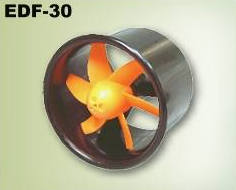 |
|||||
|
Profile Models All-sheet models were, and remain, an excellent introduction to rocket planes, and I have enjoyed reading SAM members’ experiences with these models. Whilst home-grown designs can be experimental, many kits had a pedagogical purpose, for example the Sebel "Delta-Dart-Diamond" kit of 1963, which contained three models and two 50C motors. The Skyleada ‘Silhoujettes’, KeilKraft ‘Shadow Series’ [right] and Wilmot Mansour (Jetex) Tailored profile models were last featured in SAM Speaks October 1990, well before the advent of Rapiers, so here some of them are again, to encourage readers to try these classic models with a modern motor. There were duration types like the Jetex Wren [below right], but in those days I much preferred the ‘semi scale’ offerings, especially the nicely decorated Veron "Quickys" [sic] [right] and the Jetex Sharky resplendent in silver and RAF markings [below].
|
  |
|||||

|
|
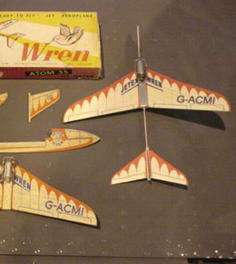
- Howard Metcalfe
|
||||
|
Somewhat paradoxically, replicating classic profile models in all their original glory is now quite time consuming. Perhaps an entrepreneur could remake some popular examples of these nostalgia-inducing kits if the demand is there. The paper F.D.2 [right] has been more popular than I expected and I have sent out eighteen reproductions so far. Ron Pasco says he didn’t design this model, or indeed the Sebel X-15, Sea Vixen or Temco TT-1, so these mysteries remain. He did however design a PAA-Loader powered glider with a vac-formed plastic fuselage, the Sebel Theron ("The Ron" – ouch!) [below right]. Curiously, one of these appeared on eBay not so long ago. Inevitably, in the correspondence about paper models that the F.D.2 engendered, the name of Wallis Rigby came up. As far as I know he only designed one aeroplane for Jetex power, the "Jetex Javelin", kitted by the American Telasco Company, though there was I believe also a boat. In my column I make references to plans and articles in old modelling magazines, annuals and even SAM Speaks that other folk may not have access to (see Alan Rabett’s letter in last month’s SAM Speaks). I usually refer to articles that I have to hand, so if any reader would like photocopies on a particularly fascinating topic please let me know. I must thank and acknowledge Tom Andrews, Peter Tolhurst, Mike Mellor and Alan Wiggs in particular for supplying me with an endless stream of stimulating reprints over the last year. |
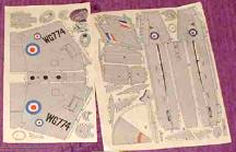
- Roger Simmonds

- Model Aircraft, Aug. 1961 (p. iv)
|
|||||
|
|
||||||
|
|
|
|||||
|
|
|
|
|
|
|
|
Acknowledgements - Article: Roger Simmonds - Illustrations: Roger Simmonds, Bert Judge, Mike Ingram, Howard Metcalfe, John McKnight, Bill Henderson, MAAC archives via Bill Henderson, Bumpy Green Model Aerodrome, GWS Grand Wing Servo-Tech Co. Ltd |
|
|
|
|
ABOUT | MOTORS | MODELS | ARCHIVE | HISTORY | STORE | FAQ | LINKS |
|
|
Terms of Use
|
Queries? Corrections? Additions?
Please
contact us.
|
|